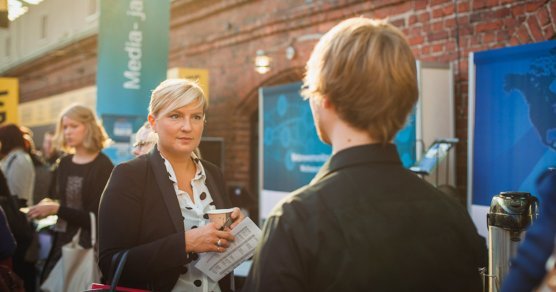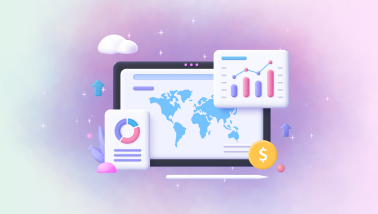Most companies – as well as their customers – operate both online and in the physical world. Like customers, companies choose what they do in which channel: is the customer service online or in-store? Where are the products browsed? Where is the customer's attention grabbed and what happens then?
O2O i.e. online-to-offline marketing means strategies that aim to get the customer to move from online into a brick and mortar store and vice versa. The essential thing is not to deliberately move the customer from one place to another but to find the right place for each action or product while providing a consistent experience between channels.
Yours truly in multiple channels
Modern customers operate in a multichannel environment and companies have to respond to this challenge. It is important to meet the customer exactly where he or she is at a particular time and in a way that feels natural to the customer.
Basically this means that the customer experience consistently stays the same and maintains its quality in all of the channels.
If your online customer service is bad or slow, it doesn't help if the in-store customer service is good – and if your website doesn't work, a good-looking store might not save the situation.
Therefore, after each contact point you should make sure that the customer experience continues towards the next contact in a natural, uninterrupted way and to the right direction. The key factor is always the next step: is the customer checking out of a hotel? Make an offer for their next stay or ask for feedback. Is the customer visiting a website? Motivate the customer to leave their contact information and let automated message chains to direct them towards the first purchase. Is a visitor enjoying an event – urge them to follow you on social media, ask for feedback and direct towards customership slowly but surely.
It is important that the customer never falls to a void or is forgotten – even and especially when purchase already has been made.
From online to offline: 10 tips
In addition to traditional online advertising and search engine visibility, moving from online to stores can happen in many ways.
- Online coupons to the physical store can be offered as SMS, via email marketing, as push notifications from applications or on Facebook, for example. The key factor is that they work well on mobile, and reach the consumers when they're on the move – near the stores.
- There are more and more services based on location: provide offers based on the customer's movements in a shopping center.
- Advertising based on stock: advertise which product is available where and target your messages based on the customer's location.
- Email marketing is still one of the best ways to reach the consumer – at least if your newsletters work on mobile too.
- Offer the possibility to pick up an online order from a store.
- Provide the in-store availability as well as the webstore selection for those who want to buy the product immediately and don't want to wait.
- Offer the possibility to return products to a store.
- Create an online shopping list that is easy to follow in the store.
- Offer the possibility to buy online gift cards to stores and vice versa.
- Timely SMS messages with discount codes work great for some markets - test with your own target group!
From offline to online: 10+ tips
Even though budgets for digital marketing are growing, the customers will always be in offline contact with companies as well: through out-of-home advertising, at events, through services, in stores. How to make these customers follow this path naturally?
The key thing is to get the customers to leave their contact information. The easiest way to accomplish this is by simply adding an easy way for the customer to find the company's online presence through their offline touchpoints: to social media, to a website, to a newsletter subscription or to an application. It is essential to give something in return for the contact information: offers, entertainment, information, service. Also personal sales efforts have their role – a recommendation from a salesperson or a presenter at an event for example.
Why is it so important to move the in-store customer online – since they've already made their purchase?
For two reasons. First of all, a webstore customer is less costly than an in-store customer. Secondly, and more importantly, the customer is lost otherwise once they walk out the door.
Making a purchase in a store can be a single transaction or the start of a long customer relationship – it's clear which is more beneficial to the company.
In practice, in-store customers do find companies' online services without help. According to a study conducted by Google, 42 % of customers take advantage of their mobile phones in stores – searching for recommendations and product reviews. The same goes for events: people search info about restaurants, advice on how to move around the location etc. Because people spend time online in any case, it's good to make sure that this time is spent in your company's own (or in your partner's) web services, not your competitor's.
- Equip your store with displays where customers can browse the webstore selection
- Offer free in-store Wi-fi that requires logging in and provide suitable services and offers straight on the login page
- At the start of an event, let the participants know on which social media platforms they can follow your company
- Provide the possibility to make purchases at the store with a scanner application or on displays and offer home delivery for the purchases
- Offer an easy way for the customer to find product reviews for the store products
- Suggest joining your loyal customer club or subscribing a mobile campaign or a newsletter at the counter – and offer a discount or a competition as an incentive
- Equip the store with visible signs to follow your company on social media
- Guide your customers to a campaign website from a direct mail campaign
- Ask for feedback or a product review online or offer an incentive
- Give a coupon to the webstore on the counter
- Offer the possibility to add products to an online wish list in stores
- Use creativity: equip a corner of your store with the possibility to send a digital postcard with your own picture or a video greeting, or create an exciting task route for children with a mobile application and augmented reality
- Share additional information about a product with a QR code, for example, or by reading a product code with an application
- Send upselling or cross-selling offers related to a purchased product to the customer by email.
Handle the big picture with automation
Customer experiences nowadays are made up of such multifaceted paths that evolve so differently that it's not easy or even possible to manage them manually. This is why it's essential that the user of both physical and digital services is identified as soon as possible – and that as many as possible of these contact points can be automated and personalized.
Once the customer's online identity is clear, the customer can really be known and the customership can be developed – contact by contact. Whatever the way of contact is, customers already expect your offers to be personalized: 85 % tell they will most likely visit stores that have personalized or limited offers, 65 % expect suggestions to buy a specific product (Google 2014: How digital connects shoppers to local stores).
Contact the Liana team if you want to learn more about the LianaCEM automation tool. With LianaCEM you can monitor the customer's signals through multiple channels and produce targeted communications based on user profiles.



![How to Get Started with Podcasts? [Infographic]](/media/blog/podcast-article/cache/starting-your-own-podcast-article-cover-378x214,c.png)